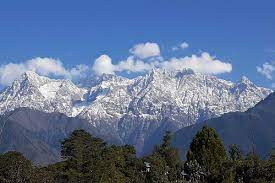Himachal Pradesh experiences a diverse climate due to its varying topography and altitude. The state’s climate can be broadly categorized into four main seasons: summer, monsoon, autumn, and winter.

Summer (April to June)
-
- Summers in Himachal Pradesh are mild and pleasant, especially in the higher altitude regions like Shimla, Manali, and Dalhousie.
- The temperature in the plains and lower valleys can rise to around 30°C (86°F) during the day, making it relatively warmer than the higher regions.
- The summer season is a popular time for tourists to visit Himachal Pradesh to escape the scorching heat of the plains.
Monsoon (July to September)
-
- The southwest monsoon brings significant rainfall to Himachal Pradesh, especially in the months of July and August.
- The region’s lush green landscapes, including dense forests and picturesque valleys, owe much of their beauty to the bountiful monsoon rains.
- However, heavy rainfall can also lead to landslides and disrupt travel in some areas, particularly in the mountainous regions.
Autumn (October to November)
-
- Autumn in Himachal Pradesh is characterized by clear skies and pleasant weather, making it an ideal time for trekking and outdoor activities.
- The temperatures start to drop, especially in the higher altitudes, preparing the region for the upcoming winter season.
Winter (December to February)
-
- Winters in Himachal Pradesh are cold and snowy, especially in the high-altitude regions, attracting many tourists, especially those seeking snowfall experiences.
- The temperatures can drop below freezing point, and heavy snowfall can occur in places like Manali, Shimla, and Kufri.
- The winter season is a significant attraction for winter sports enthusiasts, as several ski resorts open up during this time.
Himachal Pradesh’s climate is influenced by several factors
- Himalayas: The presence of the Himalayas in the northern part of the state significantly impacts the climate. The higher regions experience colder temperatures and heavy snowfall during winters.
- Altitude: The varying altitudes within the state contribute to temperature variations. The lower valleys have milder temperatures, while the higher regions experience colder climates.
- Western Disturbances: During winter, western disturbances from the Mediterranean region can bring rain and snowfall to Himachal Pradesh.
The diverse climate of Himachal Pradesh supports a wide range of activities, from summer tourism and adventure sports to winter sports and snow tourism. The state’s natural beauty, coupled with its pleasant weather throughout the year, makes it a popular destination for both domestic and international tourists. Additionally, the climate also influences the state’s agriculture, with different regions suitable for the cultivation of various crops like apples, potatoes, and peas.
Important Links